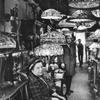Night Vision at Metropolitan Museum Features 20th-Century Photography Made After Dark
- NEW YORK, New York
- /
- April 20, 2011

Night Vision: Photography After Dark, on view at The Metropolitan Museum of Art from April 26 through September 18, 2011, will feature photography of the 20th century inspired by the pleasure, danger, and allure of the night. For more than 100 years photographers have been drawn to the challenge of making images after dark, capturing the aesthetic effects of nighttime rain, early-morning fog, shining street lamps, and dimly lit rooms. Modern camera artists have been captivated by glowing skyscrapers, dazzling neon signs, glittering nightlife, and the shadowy realm of the nocturnal underworld.
Highlights of the Metropolitan’s exhibition include classic night photography of the 1930s-1950s by Berenice Abbott, Bill Brandt, Brassaï, Robert Frank, André Kertész, William Klein, Weegee, and Garry Winogrand, as well as two early photographs by Diane Arbus that have never been shown or published before, and recently acquired photographs by Peter Hujar and Kohei Yoshiyuki.
Night Vision will present 40 black-and-white photographs dating from 1898 to 2000—all drawn from the Museum’s collection—including early night photography by Alfred Stieglitz, Edward Steichen, Frances S. Allen and Mary E. Allen, Alvin Langdon Coburn, and Lewis Hine; works from the 1920s-1930s by Giuseppe Albergamo, Ilse Bing, Marcel Bovis, Gordon H. Coster, Knud Lonberg-Holm and Werner Mantz; mid-20th-century photographs by John Cohen, Louis Faurer, Sid Grossman, Otto Steinert, Josef Sudek, and Pim Van Os; and photographs from the latter part of the last century by Robert Adams, David Deutsch, Patrick Faigenbaum, Daido Moriyama, Hiroshi Sugimoto, and Stephen Tourlentes.
Photography in low-light conditions first became possible in the late 1880s with the introduction of the gelatin dry-plate process, which reduced exposure times significantly. Alfred Stieglitz and Edward Steichen were among the first artists to take up the challenge of capturing images after dark. Stieglitz turned his lens on the city in such works as Reflections: Night, New York (1897) and An Icy Night (1898), while Steichen rendered the magic of the woods at dusk in Woods Twilight (1899). Alvin Langdon Coburn, a contemporary of Stieglitz and Steichen, was mesmerized by the glow of Manhattan’s electrified streetlamps, which he compared to stars lighting up the avenue, as in his photograph Broadway at Night (ca. 1910).

By the early 20th century, night photography came into its own as an artistic genre as the technical innovations of smaller handheld cameras, faster photographic film, and commercial flashbulbs freed artists to explore further the nocturnal universe of shimmering light and velvety darkness. Brassaï made his name as a chronicler of Paris after dark with the publication of his book Paris by Night in 1932. The dreamy atmosphere of Brassaï’s photographs is intensified by his preference for shooting on misty nights. “Fog and rain…tend to soften contrasts,” he wrote. “Steam, as well as wet ground,
act as reflectors and diffuse the light of the lamps in all directions. Therefore, it is necessary to photograph certain subjects in the rain, since it is the rain that makes them ‘photogenic.’”
Another pioneer of night photography, Bill Brandt portrayed the lives of all levels of British society in both staged and documentary photographs from the 1930s and 1940s. The exhibition will feature four of his works, including Soho Bedroom (1936), depicting a couple locked in a passionate embrace which was published in his influential book A Night in London (1938). Brandt also made night views of London during the Blitz, when the city imposed blackouts. He later wrote: “The darkened town, lit only by moonlight, looked more beautiful than before or since.”
Inspired by Brassaï and Brandt, other photographers began to turn their attention to the social life of the city at night, from the convivial hubbub of Little Italy’s Feast of San Gennaro—as seen in works by Diane Arbus and Sid Grossman—to the top-hatted elegance of opening night at the opera, in a 1955 photograph by Garry Winogrand. Night photographers have also been drawn to outlaws and lone figures on the margins, picturing the dark hours as a shadowy realm of transgression. Peter Hujar spent many nights wandering the streets of downtown Manhattan with his camera, creating images that exude a sense of expectation and desire. Hujar’s 1981 photograph Man in Park is one of three photographs he made of men cruising in Stuyvesant Square Park.
More recently, artists have adapted techniques of police and military surveillance to pry into hidden corners of the night. In the early 1970s, Kohei Yoshiyuki used infrared film to capture nighttime images of clandestine sexual encounters in Tokyo’s public parks, capturing amorous young couples as well as the peeping Toms who gathered in the bushes to watch them. For his “Night Sun” series (2000), David Deutsch shot overhead views of Los Angeles suburbs at night from a helicopter, illuminating the houses below with a police search light.

Night Vision: Photography After Dark is organized by Mia Fineman, Assistant Curator in the Department of Photographs.
In conjunction with the exhibition, on Friday, June 17, at 6 p.m. the Museum will present a screening of the classic film noir Night and the City (1950), directed by Jules Dassin. The film is set in the seedy underworld of London and features Richard Widmark and Gene Tierney. In addition, the Museum will offer gallery talks by Mia Fineman on June
17, June 29, July 14, and July 26 at 11 a.m.
The exhibition will be featured on the Museum’s website at www.metmuseum.org.








100x100_c.jpg)







